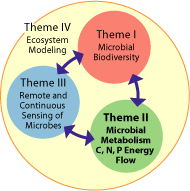- C-MORE Home
- Member Area
- What is Microbial Oceanography?
- What is C-MORE?
- C-MORE Hale
- Research
- Theme I: Microbial Biodiversity
- Theme II: Metabolism and C, N, P & Energy Flow
- Theme III: Remote and Continuous Sensing; Links to Climate Variablilty
- Theme IV: Ecosystem Modeling, Simulation, and Prediction
- Research Cruises
- Data
- Education & Outreach
- People
- Publications
- Microscopy Images
- Professional Development Training Program
- Summer Course
- C-MORE Highlights
- Meeting Facilities
- Contact Us
 Research Themes
Research Themes
Theme II: Microbial metabolism and the mechanisms of
C, N, P, and energy
flow in the sea

Jonathan P. Zehr (Theme II Leader)
University of California at Santa Cruz (UCSC)
The C-MORE Theme II is an integrated cornerstone of the objectives of the Center to discover, monitor and model the roles of microbes in Earth’s biogeochemical cycles. The ocean’s microorganisms include nonliving viral particles, Archaea, Bacteria and Eukaryotes that vary in size over several orders of magnitude. The microscopic organisms of the sea form entire food web structures, called the microbial loop, that feed nutrients and biomass into the food chains of microorganisms, recycle nutrients that maintain ocean productivity and perform a number of special elemental transformations that regulate the availability of nutrients as well as regulate carbon and nutrient flux to the deep sea in the form of particles, and to the atmosphere in the form of gases.
 Theme II embodies the activities of microorganisms, interactions among
microorganisms including viral interactions, gene exchanges,
symbiosis, formation and consumption of organic matter, predation and
the roles of microorganisms in elemental transformations including
particle and gas fluxes throughout the oceanic realm and between the
atmosphere and the ocean. Theme II objectives are tightly linked to
Theme I discoveries of genes and organisms and the use of model
organisms isolated in cultivation efforts. Theme II is also critical
for Themes III and IV in identifying and quantifying key
microbiological functions and chemical transformations that need to be
monitored routinely in the oceans and that can be incorporated in
predictive models of the ocean’s roles in the biosphere.
Theme II embodies the activities of microorganisms, interactions among
microorganisms including viral interactions, gene exchanges,
symbiosis, formation and consumption of organic matter, predation and
the roles of microorganisms in elemental transformations including
particle and gas fluxes throughout the oceanic realm and between the
atmosphere and the ocean. Theme II objectives are tightly linked to
Theme I discoveries of genes and organisms and the use of model
organisms isolated in cultivation efforts. Theme II is also critical
for Themes III and IV in identifying and quantifying key
microbiological functions and chemical transformations that need to be
monitored routinely in the oceans and that can be incorporated in
predictive models of the ocean’s roles in the biosphere.



